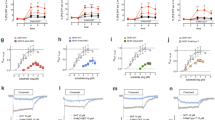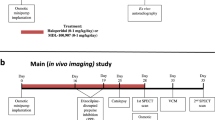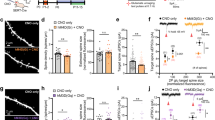Abstract
Serotonin (5-HT) releasing agents such as d-fenfluramine are known to cause long-term depletion of forebrain 5-HT in animals, but the mechanism of this effect is unknown. In the present study, we examined the relationship between drug-induced 5-HT release and long-term 5-HT depletion in rat brain. The 5-HT-releasing actions of d-fenfluramine and a non-amphetamine 5-HT drug, 1-(m-chlorophenyl)piperazine (mCPP), were compared using in vivo microdialysis in the nucleus accumbens. The ability of d-fenfluramine and mCPP to interact with 5-HT transporters was tested using in vitro assays for [3H]5-HT uptake and radioligand binding. Local infusion of d-fenfluramine or mCPP (1–100 μM) increased extracellular 5-HT, with elevations in dopamine occurring at high doses. Intravenous injection of either drug (1–10 μmol/kg) produced dose-related increases in 5-HT without affecting dopamine. d-Fenfluramine and mCPP exhibited similar potency in their ability to stimulate 5-HT efflux in vivo and interact with 5-HT transporters in vitro. When rats received high-dose d-fenfluramine or mCPP (10 or 30 μmol/kg, i.p., every 2 h, 4 doses), only d-fenfluramine-treated rats displayed long-term 5-HT depletions. Thus, mCPP is a 5-HT releaser that does not appear to cause 5-HT depletion. Our data support the notion that 5-HT release per se may not be sufficient to produce the long-term 5-HT deficits associated with d-fenfluramine and other amphetamines.
Similar content being viewed by others
Log in or create a free account to read this content
Gain free access to this article, as well as selected content from this journal and more on nature.com
or
References
Appel NM, Mitchell WM, Contrera JF, De Souza EB . (1990): Effects of high dose fenfluramine treatment on monoamine uptake sites in rat brain: Assessment using quantitative autoradiography. Synapse 6: 33–44
Baumann MH, Rutter JJ, Auerbach SB . (1993): Intravenous administration of the serotonin agonist m-chlorophenylpiperazine (mCPP) increases extracellular serotonin in the diencephalon of awake rats. Neuropharmacology 32: 1381–1385
Baumann MH, Char GU, De Costa BR, Rice KC, Rothman RB . (1994): GBR12909 attenuates cocaine-induced activation of mesolimbic dopamine neurons in the rat. J Pharmacol Exp Ther 271: 1216–1222
Baumann MH, Mash DC, Staley JK . (1995): The serotonin agonist m-chlorophenylpiperazine (mCPP) binds to serotonin transporter sites in human brain. Neuroreport 6: 2150–2152
Baumann MH, Ayestas MA, Rothman RB . (1998): Functional consequences of central serotonin depletion produced by repeated fenfluramine administration in rats. J Neurosci 18: 9069–9077
Bengel D, Issacs KR, Heils A, Lesch KP, Murphy DL . (1998): The appetite suppressant d-fenfluramine induces apoptosis in human serotonergic cells. Neuroreport 9: 2989–2993
Berger UV, Gu XF, Azmitia EC . (1992): The substituted amphetamines 3,4-methylenedioxymethamphetamine, methamphetamine, p-chloroamphetamine and fenfluramine induce 5-hydroxytryptamine release via a common mechanism blocked by fluoxetine and cocaine. Eur J Pharmacol 215: 153–160
Boja JW, Mitchell WM, Patel A, Kopajtic T, Carroll FI, Lewin AH, Abraham P, Kuhar MJ . (1992): High-affinity binding of [125I]RTI-55 to dopamine and serotonin transporters in rat brain. Synapse 12: 27–36
Caccia S, Anelli M, Ferrarese A, Fracasso C, Garattini S . (1992): Single- and multiple-dose kinetics of d-fenfluramine in rats given anorectic and toxic doses. Xenobiotica 22: 217–225
Cadet JL, Brannock C . (1998): Free radicals and the pathobiology of brain dopamine systems. Neurochem Int 32: 117–131
Carboni E, Di Chiara G . (1989): Serotonin release estimated by transcortical dialysis in freely-moving rats. Neuroscience 32: 637–645
Clausing P, Newport GD, Bowyer JF . (1998): Fenfluramine and norfenfluramine levels in brain microdialysate, brain tissue, and plasma of rats administered doses of d-fenfluramine known to deplete 5-hydroxytryptamine levels in brain. J Pharmacol Exp Ther 284: 618–624
Clineschmidt BV, Zacchei AG, Totaro JA, Pflueger AB, McGuffin JC, Wishousky TI . (1978): Fenfluramine and brain serotonin. Ann N Y Acad Sci 308: 222–241
Commins DL, Axt KJ, Vosmer G, Seiden LS . (1987): 5,6-Dihydroxytryptamine, a serotonin neurotoxin, is formed endogenously in rat brain. Brain Res 403: 7–14
Connolly HM, Crary JL, McGoon MD, Hensrud DD, Edwards BS, Schaff HV . (1997): Valvular heart disease associated with fenfluramine-phentermine. New Eng J Med 337: 581–588
Cozzi NV, Frescas S, Marona-Lewicka D, Huang X, Nichols DE . (1998): Indan analogs of fenfluramine and norfenfluramine have reduced neurotoxic potential. Pharmacol Biochem Behav 59: 709–715
Eriksson E, Engberg G, Bing O, Nissbrandt H . (1999): Effects of mCPP on the extracellular concentrations of serotonin and dopamine in rat brain. Neuropsychopharmacology 20: 287–296
Fuller RW, Snoddy HD, Mason NR, Owen JE . (1981): Disposition and pharmacological effects of m-chlorophenylpiperazine in rats. Neuropharmacology 20: 155–162
Fuller RW, Snoddy HD, Robertson DW . (1988): Mechanisms of effects of d-fenfluramine on brain serotonin metabolism in rats: uptake inhibition versus release. Pharmacol Biochem Behav 30: 715–721
Fuxe K, Hamberger B, Farnebo L-O, Ogren S-O . (1975): On the in vivo and in vitro actions of fenfluramine and its derivatives on central monoamine neurons, especially 5-hydroxytryptamine neurons, and their relation to the anorectic activity of fenfluramine. Postgrad Med J 51(Suppl 1):35–45
Garattini S, Jori A, Buczko W, Samanin R . (1975): The mechanism of action of fenfluramine. Postgrad Med J 51(Suppl 1):27–34
Garattini S, Mennini T, Samanin R . (1989): Reduction of food intake by manipulation of central serotonin. Br J Psychiatry 155(Suppl 8):41–51
Gundlah C, Martin KF, Heal DJ, Auerbach SB . (1997): In vivo criteria to differentiate monoamine reuptake inhibitors from releasing agents: Sibutramine is a reuptake inhibitor. J Pharmacol Exp Ther 283: 581–591
Jiang XR, Wrona MZ, Dryhurst G . (1999): Tryptamine-4,5-dione, a putative endotoxic metabolite of the superoxide-mediated oxidation of serotonin, is a mitochondrial toxin: Possible implications in neurodegenerative brain disorders. Chem Res Toxicol 12: 429–436
Johnson MP, Nichols DE . (1990): Comparative serotonin neurotoxicity of the stereoisomers of fenfluramine and norfenfluramine. Pharmacol Biochem Behav 36: 105–109
Johnson MP, Huang X, Oberlender R, Nash JF, Nichols DE . (1990): Behavioral, biochemical, and neurotoxicological actions of the α-ethyl homologue of p-chloroamphetamine. Eur J Pharmacol 191: 1–10
Johnson MP, Conarty PF, Nichols DE . (1991): [3H]Monoamine releasing and uptake inhibition properties of 3,4-methylenedioxymethamphetamine and p-chloroamphetamine analogues. Eur J Pharmacol 200: 9–16
Kahn RS, Wetzler S . (1991): m-Chlorophenylpiperazine as a probe of serotonin function. Biol Psychiatry 30: 1139–1166
Kleven MS, Seiden LS . (1989): D-, L-, and DL-Fenfluramine cause long-lasting depletions of serotonin in rat brain. Brain Res 501: 351–353
Levi G, Raiteri M . (1993): Carrier-mediated release of neurotransmitters. Trends Neurosci 16: 415–419
McCann U, Hatzidimitriou G, Ridenour A, Fischer C, Yuan J, Katz J, Ricaurte G . (1994): Dexfenfluramine and serotonin neurotoxicity: Further preclinical evidence that clinical caution is indicated. J Pharmacol Exp Ther 269: 792–798
McCann UD, Seiden LS, Rubin LJ, Ricaurte GA . (1997): Brain serotonin neurotoxicity and primary pulmonary hypertension from fenfluramine and dexfenfluramine. J Am Med Assoc 278: 666–672
McTavish D, Heel RC . (1992): Dexfenfluramine: A review of its pharmacological properties and therapeutic potential in obesity. Drugs 43: 713–733
Nichols DE, Brewster WK, Johnson MP, Oberlender R, Riggs RM . (1990): Non-neurotoxic tetralin and indan analogues of 3,4-(methylenedioxy)amphetamine. J Med Chem 33: 703–710
Nichols DE . (1994): Medicinal chemistry and structure-activity relationships. In Cho AK, Segal DS (eds), Amphetamine and its Analogs: Psychopharmacology, Toxicology, and Abuse. New York, Academic Press, pp 1–41
Owens MJ, Morgan WN, Plott SJ, Nemeroff CB . (1997): Neurotransmitter receptor and transporter binding profile of antidepressants and their metabolites. J Pharmacol Exp Ther 283: 1305–1322
Pettibone DJ, Williams M . (1984): Serotonin-releasing effects of substituted piperazines in vitro. Biochem Pharmacol 9: 1531–1537
Porter RHP, Benwell KR, Lamb H, Malcolm CS, Allen NH, Revell DF, Adams DR, Sheardown MJ . (1998): Functional characterization of agonists at recombinant human 5-HT2A, 5-HT2B and 5-HT2C receptors in CHO-K1 cells. Br J Pharmacol 128: 13–20
Rothman RB, Lewis B, Dersch CM, Xu H, Radesca L, de Costa BR, Rice KC, Kilburn RB, Akunne HC, Pert A . (1993): Identification of a GBR12935 homolog, LR1111, which is over 4000-fold selective for the dopamine transporter, relative to serotonin and norepinephrine transporters. Synapse 14: 34–39
Rothman RB, Cadet JL, Akunne HC, Silverthorn ML, Baumann MH, Carroll FI, Rice KC, de Costa BR, Partilla JS, Wang JB . (1994): Studies of the biogenic amine transporters. IV. demonstration of a multiplicity of binding sites in rat caudate membranes for the cocaine analog [125I]RTI-55. J Pharmacol Exp Ther 270: 296–309
Rothman RB, Ayestas MA, Dersch CM, Baumann MH . (1999): Aminorex, fenfluramine and chlorphentermine are serotonin transporter substrates: Implications for primary pulmonary hypertension. Circulation 100: 869–875
Rothman RB, Baumann MH, Savage JE, Rauser L, McBride A, Hufeisen J, Roth BL . (2000): Evidence for possible involvement of 5-HT2B receptors in the cardiac valvulopathy associated with fenfluramine and other serotonergic medications. Circulation 102: 2836–2841
Rudnick G . (1997): Mechanisms of biogenic amine transporters. In Reith MEA (ed), Neurotransmitter Transporters: Structure, Function, and Regulation. Totowa NJ, Humana Press, pp 73–100
Sabol KE, Richards JB, Seiden LS . (1992): Fluoxetine attenuates the d,l-fenfluramine-induced increase in extracellular serotonin as measured by in vivo microdialysis. Brain Res 585: 421–424
Sanders-Bush E, Bushing JA, Sulser F . (1975): Long-term effects of p-chloroamphetamine and related drugs on the central serotonergic mechanisms. J Pharmacol Exp Ther 192: 33–41
Schmidt CJ, Abbate GM, Black CK, Taylor VL . (1990): Selective 5-hydroxytryptamine2 receptor antagonists protect against the neurotoxicity of methylenedioxy methamphetamine in rats. J Pharmacol Exp Ther 255: 478–483
Schmidt CJ, Taylor VL, Abbate GM, Neiduzak TR . (1991): 5-HT2 antagonists stereoselectively prevent the neurotoxicity of 3,4-methylenedioxymethamphetamine by blocking the acute stimulation of dopamine synthesis: reversal by L-Dopa. J Pharmacol Exp Ther 256: 230–235
Schoeffter P, Hoyer D . (1989): Interaction of arylpiperazines with 5-HT1A, 5-HT1B, 5-HT1C, and 5-HT1D receptors: Do discriminatory 5-HT1B receptor ligands exist? Naunyn-Schmiedeberg's Arch Pharmacol 339: 675–683
Schuldiner S, Steiner-Mordoch S, Yelin R, Wall SC, Rudnick G . (1993): Amphetamine derivatives interact with both plasma membrane and secretory vesicle biogenic amine transporters. Mol Pharmacol 44: 1227–1231
Schwartz D, Hernandez L, Hoebel BG . (1989): Fenfluramine administered systemically or locally increases extracellular serotonin in the lateral hypothalamus as measured by microdialysis. Brain Res 482: 261–270
Seiden LS, Sabol KE . (1996): Methamphetamine and methylenendioxy-methamphetamine neurotoxicity: Possible mechanisms of cell destruction. NIDA Res Monogr 163: 251–276
Series HG, Cowen PJ, Sharp T . (1994): p-Chloroamphetamine (PCA), 3,4-methylenedioxymethamphetamine (MDMA) and d-fenfluramine pretreatment attenuates d-fenfluramine-evoked release of 5-HT in vivo. Psychopharmacology 116: 508–514
Steranka LR, Sanders-Bush E . (1979): Long-term effects of fenfluramine on central serotonergic mechanisms. Neuropharmacology 18: 895–995
Ulrichsen J, Partilla JS, Dax EM . (1992): Long-term administration of m-chlorophenylpiperazine (mCPP) to rats induces changes in serotonin receptor binding, dopamine levels and locomotor activity without altering prolactin and corticosterone secretion. Psychopharmacology 107: 229–235
Wolf WA, Kuhn DM . (1991): 5-HT transporter is an additional site of action for the 5-HT agonists RU24969 and TFMPP. Neurochem Int 19: 39–44
Wrona MZ, Dryhurst G . (1998): Oxidation of serotonin by superoxide radical: Implications to neurodegenerative brain disorders. Chem Res Toxicol 11: 639–650
Yang Z, Wrona M, Dryhurst G . (1997): 5-Hydroxy-3-ethylamino-2-oxindole is not formed in rat brain following a neurotoxic dose of methamphetamine: Evidence that methamphetamine does not induce the hydroxy radical-mediated oxidation of serotonin. J Neurochem 68: 1929–1941
Zaczek R, Battaglia G, Culp S, Appel NM, Contrera JF, De Souza EB . (1990): Effects of repeated fenfluramine administration on indices of monoamine function in rat brain: Pharmacokinetic, dose response, regional specificity and time course data. J Pharmacol Exp Ther 253: 104–112
Author information
Authors and Affiliations
Rights and permissions
About this article
Cite this article
Baumann, M., Ayestas, M., Dersch, C. et al. 1-(m-Chlorophenyl)piperazine (mCPP) Dissociates In Vivo Serotonin Release from Long-Term Serotonin Depletion in Rat Brain. Neuropsychopharmacol 24, 492–501 (2001). https://doi.org/10.1016/S0893-133X(00)00221-9
Received:
Revised:
Accepted:
Issue date:
DOI: https://doi.org/10.1016/S0893-133X(00)00221-9
Keywords
This article is cited by
-
Evidence for a Role of Transporter-Mediated Currents in the Depletion of Brain Serotonin Induced by Serotonin Transporter Substrates
Neuropsychopharmacology (2014)
-
Serotonergic modulation of odor input to the mammalian olfactory bulb
Nature Neuroscience (2009)
-
3,4-Methylenedioxymethamphetamine (MDMA) neurotoxicity in rats: a reappraisal of past and present findings
Psychopharmacology (2007)
-
N-Substituted Piperazines Abused by Humans Mimic the Molecular Mechanism of 3,4-Methylenedioxymethamphetamine (MDMA, or ‘Ecstasy’)
Neuropsychopharmacology (2005)



